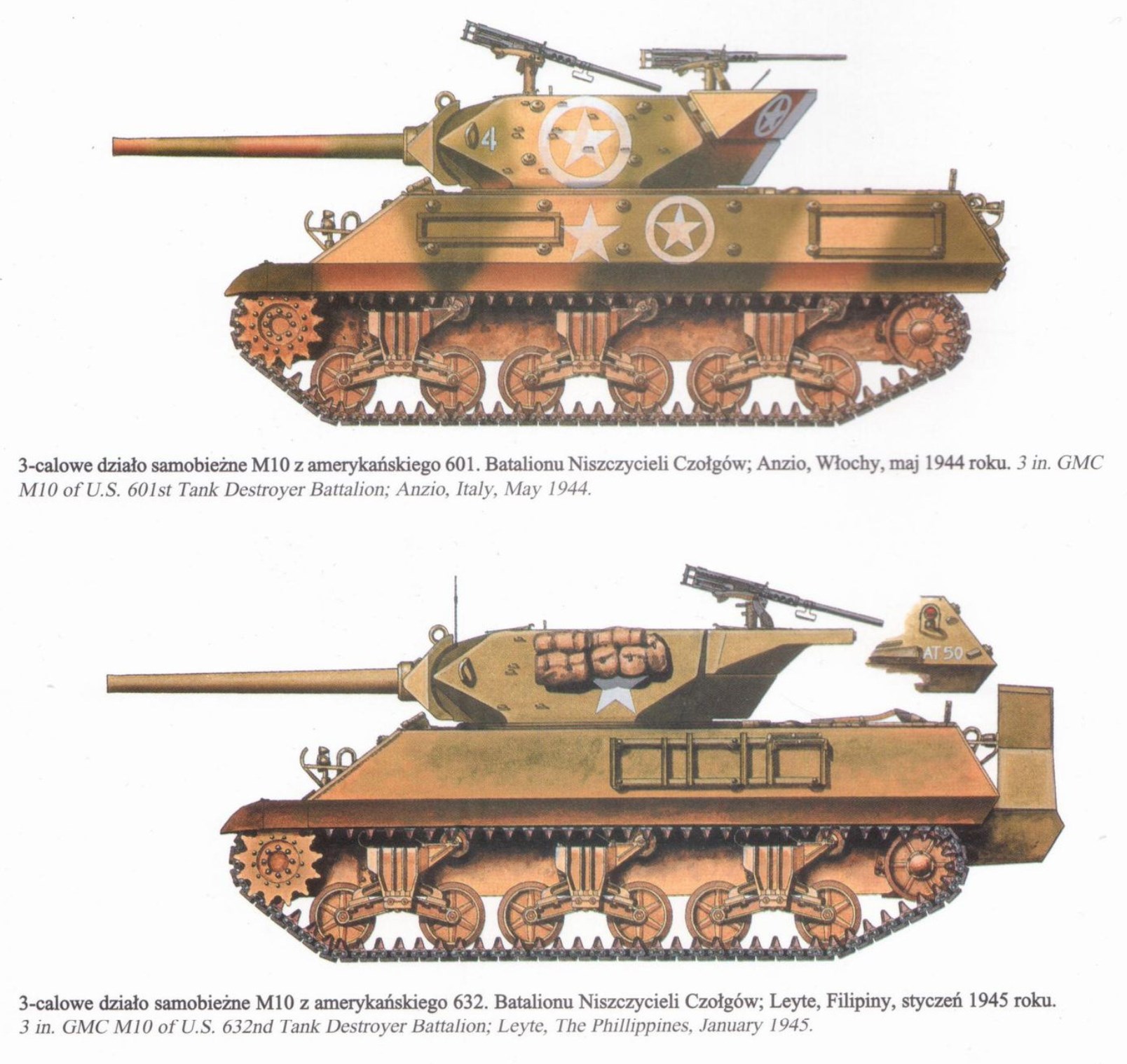
Following the successful fitting of a 105mm howitzer on the
medium tank chassis, plans were made in April 1942 to mount a high velocity gun
on the medium chassis to provide a complementary SP vehicle for the Tank
Destroyer Command. Designated T35 this vehicle utilised an early production
M4A2 tank chassis, then just available, with an open-topped low sloped turret
adapted from the turret design for the T1 Heavy Tank, and the 3in gun projected
for the same vehicle. However, the Tank Destroyer Board asked for a lower
silhouette and angled hull superstructure, so an improved design T35E1 was
drawn up, again on the M4A2 chassis, and incorporating these features. The T35E1
was modified with thinner armour than the T35 and the circular turret was
subsequently abandoned in favour of a five-sided welded turret. As finalised,
the design was standardised in June 1942 and designated M10 GMC. In order to
increase production, use of the M4A3 chassis was also authorised and vehicles
built on this chassis were designated M10A1 GMC. Most of these were retained in
America for training or converted to prime movers, M35. Others were allocated
to Lend-Lease shipments to Britain. Grand Blanc Arsenal built 4,993 M10s
between September 1942 and December 1943. Ford built 1,038 M10A1 between
October 1942 and September 1943, and Grand Blanc built 675 M10A1,
September-November 1943. 300 of the latter batch, however, were completed with
new turrets as M36 (T71) GMC.
M35 Prime Mover towing 240mm gun, France, early 1945.
Full-Track Prime
Mover M35: M10A1 converted by removal of turret and fitting of air
compressor and cables for towing 155mm and 240mm artillery pieces. Crew: 6;
weight: 55,000Ib.
British 17pdr Achilles IIC conversion of M10A1, showing gun at maximum
elevation.
BRITISH SERVICE
A number of M10s and M10A1s were supplied to Britain in 1944
where they were designated “3in SP, Wolverine”. These were issued for
combat service to British units in Italy and France; most were converted from
late 1944 by replacement of the 3in gun with the British 17pdr gun, producing a
much more potent tank destroyer than the M10 in its original form. In its new
guise the vehicle was designated “17pdr SP. Achilles Mk IC”. M10A1s
similarly converted were designated Achilles Mk IIC. The original mantlet was
retained in this conversion. First in service in limited numbers in 21 Army
Group in early 1945, the Achilles was used for many years post-war by the
British. This was a most successful conversion.
British M10 gun tower converted to experimental mine plough, 1945.
Vehicles not converted were altered to gun towers by the
removal of the turret and at least one of these was tested as an experimental
mine plough.
SPECIFICATION
Designation: Gun Motor Carriage M10 or M10A1
Crew: 5 (commander, driver, gun crew (3))
Battle weight: 66,000lb
Dimensions: Length 19ft 7in Height 8ft 1tin Width 10ft
Armament: Main: 1 x 3in gun M7 (1 x 17pdr OQF in Achilles)
Secondary: 1 x ·50 cal Browning MG (AA)
Armour thickness: Maximum 37mm Minimum 12mm
Traverse: 360°. Elevation limits:
+19° to -10°
Engine: Twin GMS 6-71 diesels (M10) Ford GAA V8 petrol (M10A)
Maximum speed: 30mph
Maximum cross-country speed: 20mph (approx)
Suspension type: Vertical volute
Road radius: 200 miles
Fording depth: 3ft Vertical obstacle: 2ft
Trench crossing: 7ft 6in
Ammunition stowage: 54 rounds 3in 300 rounds ·50 cal MG
Special features/remarks: Standard M4 series chassis and motors
but with entirely different well-sloped hull affording good armour protection.
Retrospective modification was fitting of 2,500lb weight to turret rear to give
better balance to turret. Late production vehicles had modified shape to rear
of turret. British Achilles conversion with 17pdr gun was much superior in
hitting power to original M10.